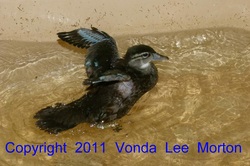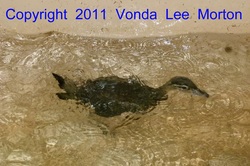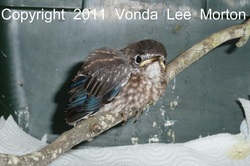The barn swallow was released shortly after the last update. She didn’t look back; barn swallows seldom hang around after they’re released.








July 17…










|
Sorry for the delay in getting out an update; the paying job is keeping me busy, busy…as in 4 hours’ sleep a night is a good night… ANYway, on to the critters; you’re not here to hear about how I pay the bills! The barn swallow was released shortly after the last update. She didn’t look back; barn swallows seldom hang around after they’re released.  We’re having a massive overlap of fur and feathers at the moment, as I have late birds and early squirrels and clueless possums. I debated posting photos of the squirrels, as some of my new friends from the NYT Hawkcam chat might feel conflicted at the cuteness of these future candidates for hawk fodder. Yes, folks, I’m a realist—squirrels are prey animals. I rehab them; hawks and owls eat them. It’s called the food chain…  The possums came in on July 28, just as their eyes were beginning to open.  This photo was taken on August 12. What a difference two weeks makes, huh?!  I also had a mocker with a ruptured air sac come in. The technical term for this is subcutaneous emphysema. Birds, in addition to having hollow bones, have air sacs throughout their bodies; it’s this combination that allows them to fly. Various types of trauma, ranging from a hard fall from the nest to being attacked by a cat, can cause one or more air sacs to rupture. The air then migrates to the surface of the skin and looks like a huge blister.  If they’re not in awkward locations, they can be left alone and the air will gradually be re-absorbed. In this bird’s case, the ruptured air sac was causing his leg to splay out to the side, so I drained it. Unfortunately he died several days later from other issues. Ruptured air sacs are rarely fatal unless they migrate near the throat and cause choking.  These scruffy looking Carolina wrens are little miracle birds. They travelled from Maryland to Georgia, a good 18 hour trip, with no food or water. Their nest was in the driver’s vehicle and he didn’t realize it until he reached Georgia. (This is not uncommon for Carolina wrens, as they nest in odd places: boat motors, tractor tires, motorcycle helmets, pants pockets…) Three of the five nestlings had died by the time he found them; these two looked very iffy. I really didn’t think they’d make it, to be honest, but I went through the necessary procedure to rehydrate them and get some food into them, hoped for the best and expected the worst.  Here they are three days later—still scruffy looking but alive! Scruffy and alive ain’t a bad combo, folks!  For those of you enamored of the wood duck, she has now been released. Yes, as her feathers came in completely, we determined she was female! At right and are photos of her prior to and at her release. July 17…  July 22…  Another July 22…  And another…she was so darn cute that day! Notice the difference in her wing feathers from July 17.  July 29…  And at left and below we have her release photos, from August 12. After carefully checking out the water, she waded in and swam around for a while before soaring over the pond and circling down to land on the opposite side but still in the water. See how her wings now cross over her back? That’s the determining factor in releasing wood ducks.  Thanks to Shelley and Chris Baumann for allowing me to use their pond as a release site. For those of you who may not remember, Shelley is one of the wonderful vets at Smalley’s Animal Hospital; her husband Chris is a wildlife biologist with Georgia DNR.  Of course, those of you who have followed this blog for a while know that I absolutely adore Eastern bluebirds, and this gorgeous little lady came in August 4. She was found huddled against the curb in the parking lot of a local business. How she got there is anyone’s guess, as nowhere in that area is known as bluebird habitat.  She was just days away from fledging and should have still been in the nest, so my best guess is some predator killed her sibs and she somehow escaped. She’s adjusted well to rehab, though, and is even beginning to attempt—and sometimes succeed at—eating mealworms on her own. Mealies aren’t a complete source of nutrition, but they’re commonly used in rehab to coax birds to self-feed, as they’re very slow and easy for beginning eaters to catch.  How do I know she’s female? Look at her flight feathers, or primaries. They’re a dusky blue. Males have much more vivid primaries—almost a cobalt blue. Of course, she’ll lose the baby spots as she matures and goes through her first molt, but the dusky, muted blue will always serve as the indicator that she’s female.  Everything bluebirds do is just precious to me; can you tell? Here she looks like she’s planning to audition as a contortionist for Cirque de Soleil, but she’s actually preening after starting her bath. She hopped in the water, got a little damp, preened a bit and then decided she needed a full bath, below. She's out of her pen for the bath; it's less messy that way! And that’s a good way to wrap up this update. By the way, for those of you on Facebook, Laurens Wildlife Rescue now has a Facebook page. I generally post the photos from these updates there within a day or two of the update. They’re larger and clearer on Facebook, for those who like to see more detail!
1 Comment
Uwestsider
8/18/2011 11:21:44 pm
GaR: you take such good care of all the little critters and I love reading your captions. Your teeny bluebird is a cutie and appears to be responding well to your loving care….very cute little bird….love the facial expressions.
Reply
Your comment will be posted after it is approved.
Leave a Reply. |
Archives
April 2023
Categories
All
|